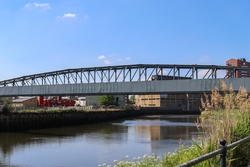How you can use this image
This image can be used for non-commercial research or private study purposes, and other UK exceptions to copyright permitted to users based in the United Kingdom under the Copyright, Designs and Patents Act 1988, as amended and revised. Any other type of use will need to be cleared with the rights holder(s).
Review the copyright credit lines that are located underneath the image, as these indicate who manages the copyright (©) within the artwork, and the photographic rights within the image.
The collection that owns the artwork may have more information on their own website about permitted uses and image licensing options.
Review our guidance pages which explain how you can reuse images, how to credit an image and how to find images in the public domain or with a Creative Commons licence available.
Notes
Add or edit a note on this artwork that only you can see. You can find notes again by going to the ‘Notes’ section of your account.
'Blue: Siemens blue for the Siemens building in Hull. A business that was planning to expand and offer hundreds of jobs to Hull residents. This building was the first building Siemens announced they would not be able to complete these plans if Brexit happened. Hull overwhelmingly voted for Brexit (most votes for any city in the UK). Orange: In the original film still the sign "Change is Happening" is in green. I printed over in Orange – as the colour that signifies waiting to see if everything is clear to move forward (traffic lights) but also alarm. It is not a road sign but a sign already referencing the road sign. It denotes direction. I suppose it is a suggested questioning of what change; when, how and for whom. Yellow: This is the entrance to Pearson park.
Unlike Manchester workers, Hull continued to work with the plantation system as part of the Triangle Trade until the abolition of slavery. The yellow represents the slave trade – forced migration – and the toil of workers.'
The prints were one part of a body of work collectively called the 'Moveable Bridge project'. It was commissioned as part of 'Beyond Words' by the Freedom Festival Arts Trust, Hull Culture and Leisure Library Services and Book Works, in association with Hull History Centre, Wilberforce Institute for the study of Slavery and Emancipation, University of Hull, funded by James Reckitt Library Trust and Arts Council England.
Cammock's research for the 'Moveable Bridge project' focused on how communities can open up and close down offering freedom and sanctuary to those within its boundaries as well as those perceived as outsiders. Hull has historically been, like many port towns, a passage point for different communities, yet in 2016 it voted overwhelmingly to leave the EU closing its doors to the outside. This closing down of community and notions of who belongs and who does not also happened after the First World War and the Second World War, when poverty, loss and politics collided with a growth of right-wing sentiment and fascism, putting little known repatriation campaigns on the agenda.
Helen Cammock works across moving image, photography, writing, poetry, spoken word, song, performance, printmaking and installation. She is interested in histories, storytelling and the excavation, re-interpretation and re-presentation of lost, unheard and buried voices. Cammock uses her own writing, literature, poetry, philosophical and other found texts, often mapping them onto social and political situations. Her work has drawn on material from Nina Simone, Philip Larkin, James Baldwin, Maya Angelou and Walter Benjamin. These texts often direct her choice of medium, such as her evocative moving image work which oscillates between the private and collective.
Title
Moveable Bridge
Accession number
1631






